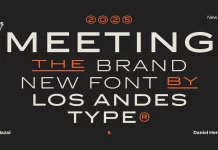This post contains affiliate links. We may earn a commission if you click on them and make a purchase. It’s at no extra cost to you and helps us run this site. Thanks for your support!
Are you struggling to choose the right font for your website? With so many options available, it can be challenging to know what font will convey the message you want and make a lasting impression on visitors.
In this blog post, we’ll take a look at what fonts are best used for different types of websites, how to select the right font based on your website’s purpose, and provide tips for choosing an effective combination of fonts that will make an impact. We’ll also discuss what you need to know about licensing fonts before using them on your website. By the end of this article, you should feel confident in selecting an excellent font choice that reflects what your brand stands for! Please read more below.

1. Overview of what font to use for your website
When designing a website, the font you choose is an essential component of the overall look and feel. Fonts are what create a typeface or style, giving words personality and structure. It’s important to select what font is going to best convey the message you want your website to present. There are some basic considerations in choosing what font to use, such as legibility, readability, usability, and accessibility. But also keep in mind how it speaks to the audience and what kind of emotion it conveys. Spend time reviewing fonts that fit what you’re looking for in terms of style and aesthetic, ensuring that it aligns with your brand identity and allows visitors to easily navigate the site’s content. With careful selection and thought put into what font is used for your website, a potential visitor can be moved from just reading about what you’ve got on offer to taking action and making that purchase or visiting more often!
2. Different types of fonts and what they are usually best used for
With so many fonts out there, it can be difficult to determine what font is best for what purpose. Each typeface brings its own unique style, with some more suited to professional documents and others better suited for more creative projects. Serifs provide a level of elegance that makes them excellent choices for formal correspondences while modern sans serifs work well with body text in print or on the web. Slab serifs give off a contemporary feel, making them ideal for titles and headlines; they also work great with larger sizes like posters. On the other hand, script fonts are perfect for thoughtful touches found in wedding invites and logo designs. Knowing what font fits what situation can take your web design project to the next level!
3. How to select the right font based on your website’s purpose
When it comes to selecting fonts for your website, what font you choose is just as important as what information you put on your website. Different fonts can make or break readability, and impact how the audience responds to your content. Choosing a typeface requires consideration since what works for a blog post may not be best for presenting technical data. Therefore, it is important to select a font that best reflects the purpose of the website and its tone of voice. While some fonts are more professional looking than others, consider opting for something personal if appropriate to match your website’s mission. Exciting new fonts tend to energize audiences and make them feel engaged with what they’re reading while traditional fonts can signal stability and trustworthiness. Ultimately what matters most is choosing what font pairs best with what purpose.
4. Tips for choosing a font that will make an impact on your visitors
It can be difficult to choose what font will make the biggest impact on your visitors, but there are a few tips that can help. The typeface you select should not distract from the content, so aim to pick one that is clear and easy to read. Different fonts can evoke different emotions, so try to determine what message your text is trying to portray – by selecting a font that reinforces this feeling you can craft an experience tailored exactly to your needs. You should also ensure the font scales well across all platforms – what may look great on a small screen may not suit larger sizes or vice versa. With a little time and effort on what font will create the greatest impact, you can give your visitors an engaging and unforgettable experience.

5. Examples of effective font combinations for websites
When it comes to font combinations for websites, the possibilities are endless. From modern typefaces all the way to classic designs, there is an array of font selections that can be used to create a perfect balance between diversity and unity. One effective combination is pairing a bold sans-serif font with a light-serif font. Another font combination idea is mixing two different typefaces of varying weights and styles together to give a bit of contrast and emphasize text hierarchy. No matter what font combinations you choose, it’s important to keep in mind that your font selections shouldn’t overpower the content and should make it easier for readers to read your web copy.
6. Considerations when selecting a web-safe or custom font
Choosing font combinations can be one of the most daunting decisions for a designer. With so many options out there, it’s important to consider the safe fonts that offer uniformity across all browsers, as well as custom font formats that can take your design to the next level. Many fonts are packaged in various font formats, including TrueType font (TTF), OpenType font (OTF), web OpenType font (WOFF), and web OpenType font format 2 (WOFF2). Each of these font types can be useful depending on the context of your project. Make sure you check whether a typeface is for print or screen use – some fonts may require an additional license to use them online. Ultimately, there’s no right answer; it’s all about finding a font combination that fits your project best and conveys the message you want to send!
7. What you need to know about licensing fonts before using them on your website
Using font license agreements is essential for protecting font creators and their intellectual property. As font creators become increasingly savvy about font protection and their legal rights to be appropriately compensated for their work, it’s important to make sure you understand font licensing before using fonts en masse on a website. When thinking of font licenses, consider the typeface as something with tangible value; font designers often spend dozens of hours refining each typeface design and are within their rights to make sure they get attribution and compensation when their font is used. Understand that not all font licenses allow commercial use across web platforms like blogs or websites, while some may have greater restrictions in place depending on the font itself. By familiarizing yourself with font licensing regulations and details, you can rest easy knowing that any font you’re using has the proper documentation that allows you to feel comfortable with your usage of the designer’s work.
8. Final thoughts – what makes a good font choice for a website
Choosing the right font for your website is no simple task, as font choice can hugely influence how users perceive your content. Ultimately, you should opt for an eye-catching font that is easy to read – whether on desktop or mobile – and reflects the personality of your website. It’s important to stay away from any font that appears generic, as this could give off the uncomfortable impression of a lack of creativity. There are plenty of great fonts out there that offer both a memorable look and readability, so explore some options and be sure to make the best font choice for your site.

Header image by Radoman Durkovic via Adobe Stock. You can find more trending typefaces for all your creative needs in the Fonts category on WE AND THE COLOR.
Subscribe to our newsletter!

















